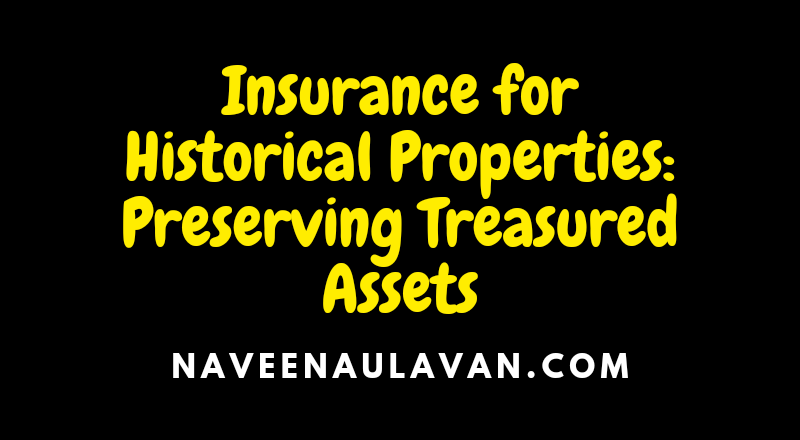Historical properties are not just ordinary buildings; they are repositories of our cultural heritage. These buildings hold immense historical architectural and cultural significance. Therefore protecting and preserving historical properties is crucial to maintain our collective heritage and ensure it is passed on to future generations.
One key aspect of safeguarding historical properties is insurance. Insurance plays a vital role in mitigating risks covering potential losses and facilitating the restoration and maintenance of these treasured assets. This article aims to explore the importance of insurance for historical properties and highlight the various insurance options available for their protection.
The Significance of Historical Properties
Historical properties are unique and irreplaceable representing a tangible link to our past. They encompass a wide range of buildings including castles manor houses palaces churches and other structures that have significant cultural architectural or historical value. These properties act as touchstones to our history providing glimpses into the lives and achievements of our ancestors.
Preserving historical properties is crucial for several reasons:
1. Cultural Heritage: Historical properties contribute to our cultural identity by representing our shared history traditions and values. They offer insights into the architectural and artistic achievements of different eras showcasing their distinctive styles and techniques.
2. Tourism and Economy: Historical properties often attract tourism providing a boost to local economies. Visitors travel from far and wide to marvel at the beauty and historical importance of these buildings contributing to local businesses hotels restaurants and attractions.
3. Education and Research: Historical properties serve as educational resources helping us learn about the past through tangible experiences. They provide opportunities for research and study allowing scholars and students to delve into specific historical periods architectural styles and societal developments.
4. Community Identity: Historical properties often form the heart of a community acting as landmarks and symbols of local pride. They foster a sense of belonging and community identity promoting civic engagement and preserving the unique character of a place.
Given the significance of historical properties protecting them from potential risks becomes essential. This is where insurance plays a crucial role.
Understanding the Risks
Historical properties face numerous risks including natural disasters fire vandalism theft and environmental factors. These risks can lead to severe damage or even complete destruction of these heritage treasures. Insurance helps mitigate these risks by providing financial protection and facilitating the necessary restoration or reconstruction work.
Natural Disasters
Historical properties are often exposed to natural disasters such as earthquakes floods hurricanes and storms. These catastrophic events can cause extensive damage to the structure historic artifacts and interior elements. Comprehensive insurance coverage helps safeguard against the financial burden of repairing and restoring the property after a natural disaster.
Fire
Fire poses a significant threat to historical properties due to their age construction materials and often outdated fire protection systems. In case of a fire the destruction can be devastating resulting in the loss of irreplaceable historical artifacts intricate woodwork and delicate stonework. Insurance policies that cover fire damage help mitigate the economic impact and aid in the restoration process.
Vandalism and Theft
Historical properties are susceptible to vandalism theft and malicious damage. Valuable artifacts paintings sculptures and other historically significant items may be targeted by thieves or vandals. Insurance coverage for theft and vandalism safeguards these precious objects and provides financial protection for repairs or replacements if damage occurs.
Environmental Factors
Environmental factors such as moisture pests and decay can deteriorate historical properties over time. Insurance coverage can address the costs associated with preventive measures regular maintenance and repairs to combat these factors and ensure the long-term preservation of the property.
Insurance Options for Historical Properties
Insuring historical properties requires specialized coverage tailored to their unique needs. Several insurance options cater specifically to historical properties providing comprehensive protection against the various risks they face.
Historical Property Insurance
Historical property insurance is designed to protect the structure and historical elements of a building. It covers damages caused by fire natural disasters vandalism and theft. This insurance generally provides coverage for both the structure itself and any historical artifacts or objects housed within it.
The coverage provided may include:
– Building structure: This covers the cost of repairing or rebuilding the property in case of damage or destruction.
– Historical features: This includes coverage for preserving or restoring historical elements such as original woodwork stained glass windows ornamentation and other architectural details.
– Artifacts and Collections: Insurance can be extended to cover valuable historical artifacts or collections housed within the property.
Liability Insurance
Liability insurance is essential for historical properties open to the public or used for events and activities. It protects against legal claims arising from injury or property damage suffered by visitors contractors or employees. Liability coverage ensures that the property owner or custodian is protected against potential lawsuits or claims.
Business Interruption Insurance
Business interruption insurance is crucial for historical properties that generate income through tourism events or rentals. It covers lost income and extra expenses incurred during the rebuilding or restoration phase following a covered loss. This insurance helps mitigate the financial impact of temporary closure or reduced operations due to damage to the property.
Valuation and Appraisal
To ensure accurate coverage and reimbursement historical properties often require specialized valuation and appraisal services. Appraisal professionals experienced in historical properties evaluate the value of the building and its contents taking into account its historical significance architectural features and artistic elements. These appraisals help establish appropriate insurance values and facilitate claims settlements.
Conclusion
Preserving historical properties is vital for safeguarding our cultural heritage and passing it on to future generations. Insurance plays a crucial role in mitigating risks and providing financial protection for historical properties against various hazards. Historical property insurance liability insurance business interruption insurance and specialized valuation services are essential components in ensuring the successful preservation of these treasured assets.
By embracing these insurance options and adopting comprehensive risk management strategies we can continue to protect and preserve the rich historical legacy embodied within these remarkable structures.
